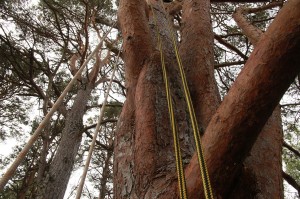
At the end of August a group of staff and students from the School of Biomedical and Biological Sciences at Plymouth University spent a week at Dundreggan, carrying out some initial exploration work in the canopy of Scots pines and oak trees there. I had already met Steve and Sarah Burchett, the organisers of the project, when they made a scouting trip to Dundreggan in May this year, and I was excited both by the prospects that their research offered, and by the possibility of climbing high up some of the trees on the estate. So, on the last day of their visit I was delighted to join them and take advantage of their expertise and skill to gain access to one of the least-visited and studied parts of the Caledonian Forest – the canopy of the mature trees.
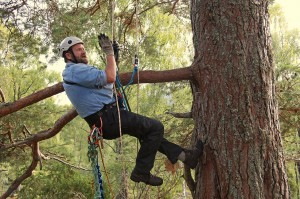
In 2004 I had climbed into the canopy of a Scots pine in Glen Affric, so I knew what I was letting myself in for, and was soon equipped with harness, safety helmet and ascenders and being instructed in the technique for climbing. With the latest equipment, it’s relatively simple to get up a tree once the ropes have been fixed in place, but it’s still a strenuous activity, as it entailed lifting my own body weight up by muscle power alone. Fortunately, it was easy to rest along the way, sitting in the harness and letting the ropes take my weight.
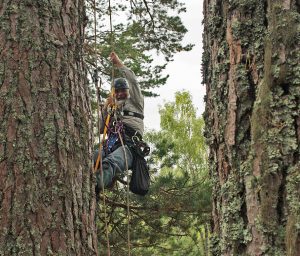
On this pine the ropes were anchored to some strong branches 16 metres up the tree, which is not high compared to the 40 metre-high anchor points used in tropical trees, where Steve and his colleagues do most of their climbing and canopy research. However, in the Caledonian Forest it’s a good height, and although not completely at the top of this pine, it did provide an excellent vantage point for viewing the upper portions of the tree and the forest canopy all around.
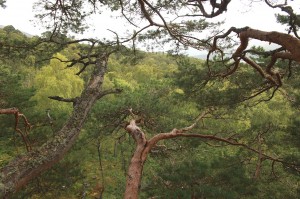
Once I was up, I took some time to relax and catch my breath as I enjoyed the view, while Kiki, one of Steve’s colleagues, fixed another rope higher up, and two of his undergraduate students also climbed up, using another set of ropes. The students had been carrying out research projects during the week, sampling the lichens and invertebrate populations at 3 different levels up the tree, to evaluate how different organisms utilise the varying habitats that the vertical dimension of the pine provides.
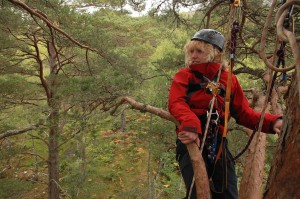
In all, the group had climbed up, and taken samples from, 3 different Scots pines and 3 oak trees on Dundreggan. This trip was very much an initial one for the group, and they will be using the results they obtain to formulate more comprehensive research proposals for longer visits in 2012 and beyond. The canopy of the Caledonian Forest has had little, if any, research carried out in it to date, and if studies in comparable forests in other countries are any indication, there should be some interesting results from their work.
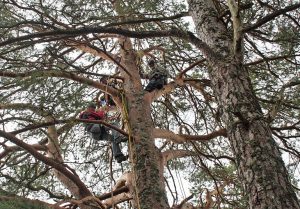
For example, a research project in the canopy of a Scots pine forest in western Norway (the closest forest type, ecologically speaking, to the Caledonian Forest) resulted in the discovery of 9 species of invertebrates previously unknown to science. It’s possible that there are undiscovered invertebrates in our pines too, and the research being planned for future years may shed some light in that regard. In 2012, Steve intends to bring more students, including a PhD student if funding can be obtained, and to stay for a longer period, also including some comparative research in the pinewoods in Glen Affric.
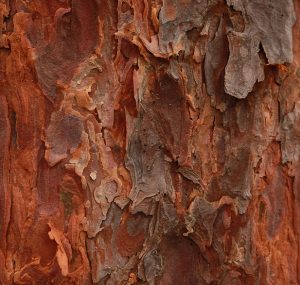
I spent almost 2 hours up in the pine altogether, taking in the structure of the upper canopy of the surrounding forest, and watching the movement of the trees as they swayed together in the day’s moderate breeze. I had an opportunity to look close up at the beautiful brick-red colour and paper-thin texture of the bark high on the pine. This contrasts with the much thicker and layered grey older bark on the lower parts of the old pines. Over the years, this young bark must thicken up and change colour, to become grey, and also gets colonised by various lichens, of which Hypogymnia physodes is the most common in our pinewoods.
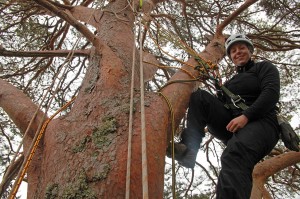
All too soon, it was time to descend back to the ground, which is a relatively graceful and effortless process, although all 3 of us up the tree this day had a minor problem. The ropes had become ‘sticky’ after a week’s use in the pines, with a coating of resin resulting in friction that inhibited our descent at one point. Once I was back down on terra firma I took some time to look up at the tree I had climbed, appreciating it anew after experiencing it from the different perspective of the loftier position I had been in. I look forward to hearing the results of the lichen and invertebrate sampling the group has carried out, and to joining Steve and his colleagues in further climbs when they return to Dundreggan in 2012.
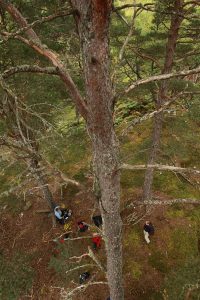
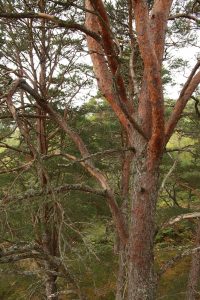
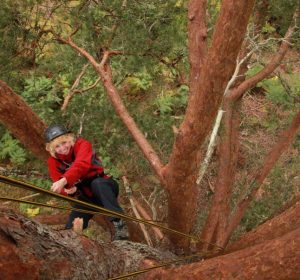
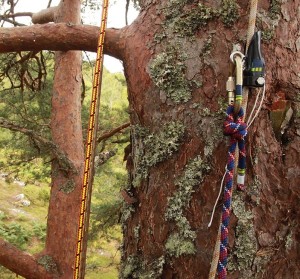
Hello, I live in California among the redwoods and am fascinated with this topic. Would you be able to tell me where the information about the 2012 follow-up (or any other studies of Scots pine canopies in Scotland) have been published? I’d also like to highly recommend The Wild Trees by Richard Preston to anyone interested in tree canopies. I’ve lived in or near redwood forests all of my life and had no idea what was up there, fascinating! http://www.amazon.co.uk/The-Wild-Trees-Passion-Daring/dp/0812975596
Hi Peggy,
Many thanks for your comment. We’re still waiting to get the reports from Plymouth University from their various trips to Dundreggan – they were there again in September 2015.
I first climbed into the canopy of a Scots pine in Glen Affric with Richard Preston when he visited Scotland in 2004. I too would recommend his book about the redwoods.
With best wishes,
Alan
Hi Alan, do you know of any follow-up studies listing various species found in Scots pine canopies of Scotland? I’m involved with the Scottish Redwood Trust and we are wondering what might be in the redwood canopies in Scotland parallel to species found in the Sierra and coast redwoods found in California (The Wild Trees). Definitely Eurasian treecreepers who build small holes in the bark to snuggle in, as well as red squirrels using the bark for their nests. Thanks!
Hi Peggy, It’s nice to hear from you again – thanks for this latest comment. Unfortunately, I’m not aware of any new studies about the species utilising the canopies of Scots pines. Steve Burchett, who I wrote about climbing with in this blog, is no longer involved in that work, and I’ve not heard of anyone else who is doing research like that. So, sorry I can’t help with this question. With best wishes, Alan.
Hello from the states,
My husband has wanted to see these majestic trees since he was a little boy. I have been doing as much research as possible in preparations for a trip there in 2014. What I am so desperate to learn is if you know of any company who would help us climb into the canopies of trees in the Caledonian Pine forest? I have sent out many emails in hopes of finding a lead. Since we would be traveling to Scotland from the U.S. we would need to work with a company since we will have no gear of our own. Many, many thanks. And cheers to the important work you do in preservation. You have all of our respect. – Melissa
Hi Melissa,
Thanks for your comment, and for your interest in the canopy of the Caledonian Forest. The staff from Plymouth University made a return visit to Dundreggan in 2012, when they spent more time in the forest canopy, but haven’t done so in 2013, because of other commitments. We’re hoping that they’ll return again in 2014, but their plans have not been formulated for next year yet. Apart from them, I’m not aware of anyone, or any organisation, that is involved in accessing the canopy of the Caledonian Forest. All I can suggest is that you check with us again in the winter, when we may know what the Plymouth University folks’ plans are for 2014.
With best wishes,
Alan
Hello! Just want to say thank you for this interesting article! =) Peace, Joy.
Thanks for the comment Joe. I haven’t received the species list from the folk at Plymouth University yet, but I suspect it won’t be until they do their more detailed and comprehensive survey next year that we’re likely to get some interesting results.
Looks like a memorable experience… I’ve often thought that the canopy fauna is probably extremely poorly known, even somewhere like the UK.
I’m dying to see what you get – fingers crossed for somethng new to science.